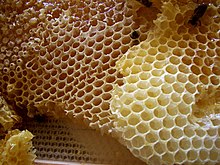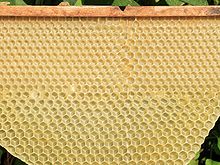honeycomb
A honeycomb is one of the honeybees from beeswax built honeycomb structure with hexagonal cells. They are used to raise larvae and to store honey and pollen . The bees use the wax glands in their bodies to produce the wax in the honeycomb.
In the beekeeping is a mobile with a honeycomb (honey, pollen or brood comb) wooden frames from a prey meant to which the bees have built the actual honeycomb. With these additional frames, honeycombs can be removed from the bee colony and also added again, for example for honey harvest, without the honeycomb structure being destroyed in the process. Honeycombs made without a frame, for example from a swarm of bees , are called wild or natural construction.
Wax production

A wax plate weighs around 0.8 milligrams, so around 1.25 million plates are required for one kilogram of beeswax. For the wax production, the bees hang together in grapes. From the wax glands on the back of the abdomen, they sweat out the wax as thin flakes. However, wax is only produced in spring from April to July when there is a good supply of nectar. Then several honeycombs can be created within a week. In principle, bees are able to build all their honeycombs themselves. This is most evident in the swarm of bees when they settle in a sheltered place and build honeycombs within a very short time.
Honeycomb construction
function
The natural tendency of bees to build honeycombs is known as the building instinct. It is most pronounced in swarms of bees, which have to create a new home within a very short time in order to survive.
The honeycombs are first of all a place of birth and habitat for the bees. The bees grow in the cells and are initially laid as an egg by the queen. During rearing and feeding by the worker bees, the egg turns into a larva, which eventually spins into the cells and pupates . The cell is provided with a wax lid by its adult sisters until after 21 days (in the case of the worker bee) the finished insect hatches out of the cell. For this purpose, a hidden wax depot is created by the workers and the cell edge is specially reinforced in the case of older maggots (stretching maggots). In this way, the cell can be covered in a very short time, which in the high breeding season (April-June) would otherwise not be possible with the bees' own wax production, who are "responsible" for the covering.
In addition, honeycombs are also a production facility and storage space for honey and pollen. Naturally, the wax honeycomb structure started above initially consists of a layer of pentagonal ceiling cells, which are then followed by the construction of similarly shaped hexagonal cells downwards. Honeycombs hanging next to each other are built with a distance (from the center of the honeycomb to the center of the honeycomb) of 35 mm. The free space between the individual vertical honeycombs corresponds roughly to the distance between the bees , just under one centimeter.
construction
An opinion that has since been refuted was that the bees do not build the honeycombs directly into hexagons, but use their own bodies as templates for normal cells (for the brood of workers ). At first, these cells would be round, which was already described in 1792 by the Swiss bee researcher François Huber . The hexagonal shape is only created by heating the wax to just under 40 ° C. The so-called transition temperatures of beeswax at 25 ° C and 40 ° C, which characterize a transition area in the molecular arrangement between crystalline and amorphous, and the physical effect of the surface tension of liquids are responsible for this. In the case of interfaces, this leads to an absolutely flat structure with a constant wall thickness. The interface between soap bubbles that come into contact with one another is often cited as an example of this effect.
However, scientific research shows that honeycomb construction is not based on a fluid equilibrium process. According to the latest research (2017), the surface tension of the wax has no influence on the honeycomb structure. Experiments show that the surface tension does not cause the wax to flow even at 55 ° C, i.e. just below the melting point (63 ° C). To that extent, the bubble analog is misleading. On honeycombs under construction, it can be observed that the bees create new rhombuses for the cell floors on the edge of the honeycomb. Together, these form the central wall in which the construction plan for the cells (both for the brood of workers and drones and for the storage of supplies) is laid down. On the raised wax lines of the middle wall, the bees build the cell walls on both sides of the honeycomb directly with a hexagonal cross-section without intermediate steps. The hexagonal cross-section of the cells is inevitably created by the combination of two construction principles: a) hexagonal closest packing of the cells and b) neighboring cells have a common cell wall. If the workers used their bodies as a template when building honeycombs, they would not be able to build drone cells. The first row of incomplete cells that the bees use to connect the honeycomb to the wall of the nest cavity cannot be explained by the cylinder construction. Likewise, the occurrence of several cell types on one honeycomb. It would also require flowable building material. However, wasps also build hexagonal honeycomb cells with great precision from non-flowable, paper-like material.
The mechanism of the self-organization of absolutely perfect hexagons, supposedly discovered in honey bees, is said to have found its expression in a technical patent for the production of regular hexagon structures. This comparison is incorrect, as the outer surfaces of the ceramic grains disappear during sintering, while there are no outer wax surfaces at all that could disappear during the construction of the honeycomb cells.
Only the cell edges that are thickened by the bees to stabilize the honeycomb are then rounded in the honeycomb. In addition to wax, propolis is also used for this.
The regularity of the cells in honeycombs is reminiscent of crystals, which led Johannes Kepler to suspect that bees had a mathematical mind. The geometry of the honeycomb was explained by the fact that the hexagonal cell row shape - also found in nature in molecules and crystals - is the most efficient. With the least amount of material, the greatest possible capacity and maximum built-up space is guaranteed, while at the same time providing maximum stability. Although this has been mathematically proven, it is not yet a compelling explanation that the bees (instinctively) choose this shape when building the honeycombs.
Cell types
A distinction is made between the types of cells
- the worker cell (5.2-5.4 mm diameter, depth 10-12 mm)
- the drone cell (6.9 mm diameter, depth 14 mm)
- the much larger, freely built queen cell (depth up to 25 mm) to create a queen bee .
In beekeeping , the beekeeper accelerates the process of building the honeycomb by adding prefabricated, approximately one millimeter thick, wax panels (center walls ) to the beehive . The bees then build their honeycombs on the prefabricated hexagonal embossing with worker cells or drone cells on both sides. The bees pull the material outwards and thus save time and material in their own honeycomb production.
In natural honeycomb construction, bees produce worker and drone cells on a honeycomb. Since the natural honeycomb structure created by the bees is more complex, the beekeeper intervenes to regulate it by adding dividing walls. However, the beekeeper usually lets the bees build the drone cells as free wild life by hanging one or two empty frames in the hive.
Honeycomb area - amount of honey
- Worker cells have a volume of 0.3 ml and each hold 0.4 g honey with a density of 1.4 g / ml
- On 1 dm² of a honeycomb there are 415 to 425 female worker cells (or 255 drone cells) on each side
- accordingly, 3 dm² - filled with honey on both sides - contain 1 kg of honey
Nest order
In every bee colony there is an order for the use of the honeycomb structure. The order is usually based on the flight opening of the cave. The breeding area is mostly oriented towards the entrance hole, the storage area away from the entrance hole. In the middle is the area of the brood nest where most of the bees are and where the young bees are mainly raised. In the honeycomb cells next to and under the brood nest, pollen is stored and the honey stores are above the brood. This nest order is created through a self-organized process.
See also
- Brood chamber
- Honey room
- Honey oil
- For the honeycomb structure in technology, see: Sandwich panel with honeycomb core
Web links
swell
- ↑ Development of bees from egg to insect at bienenschade.de, accessed on August 13, 2019.
- ↑ Jürgen Tautz, Helga R. Heilmann: The honeybee phenomenon : Spectrum Akademischer Verlag 2007. ISBN 978-3-8274-1845-6 , p. 171 ff.
- ^ Daniel Bauer, Kaspar Bienefeld: Hexagonal comb cells of honeybees are not produced via a liquid equilibrium process . In: Natural Sciences . tape 100 , no. 1 , November 14, 2012, ISSN 0028-1042 , p. 45–49 , doi : 10.1007 / s00114-012-0992-3 ( springer.com [accessed June 10, 2018]).
- ↑ Robert Oeder, Dietrich Schwabe: Honey bees (Apis Mellifera) build the rhombic central wall and the hexagonal cells of their honeycombs directly and without intermediate structures . In: Oberhessische Naturwissenschaftliche Zeitschrift . tape 67 . Druckerei Bender GmbH, 2017, ISSN 0340-4498 , p. 8-27 .
- ^ Robert Oeder, Dietrich Schwabe: Evidence that no liquid equilibrium process is involved in the comb building of honey bees (Apis Mellifera). Retrieved November 1, 2017 .
- ↑ The Trick of the Bees PdF file retrieved from dlr.de.
- ^ Archive link ( Memento from June 11, 2007 in the Internet Archive ).




